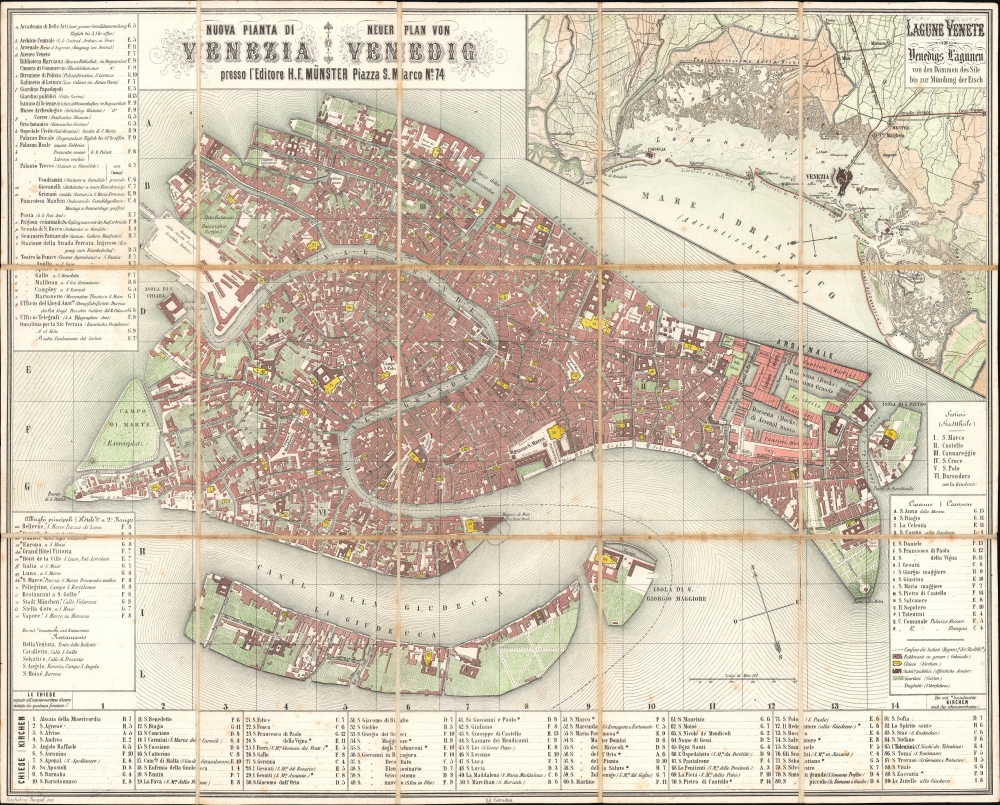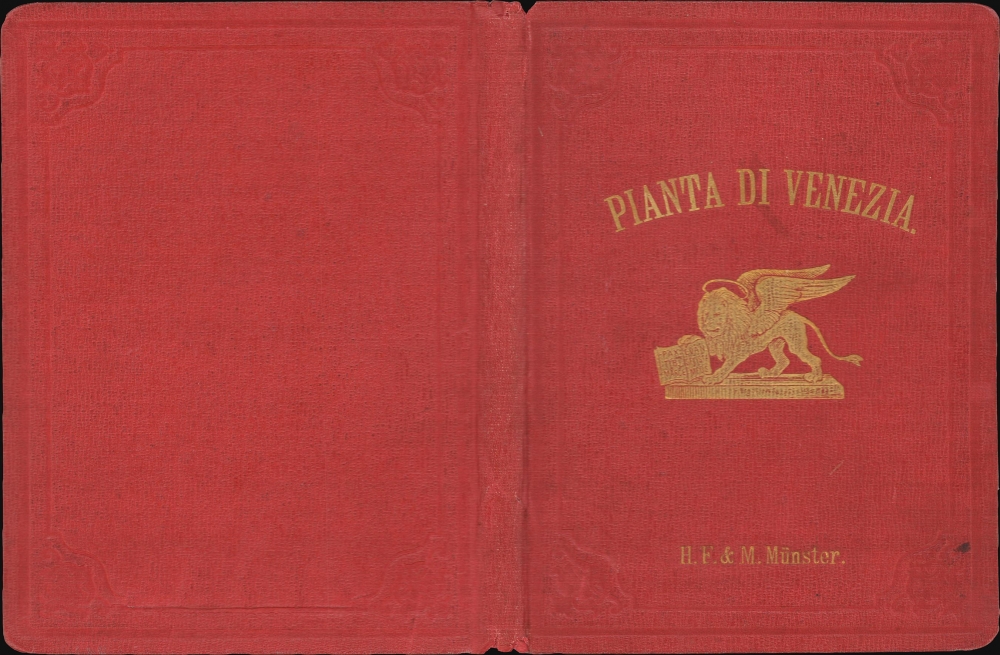1858 H.F. Münster City Plan or Map of Venice, Italy
NuovaVenezia-munster-1858
Title
1858 (undated) 17 x 21 in (43.18 x 53.34 cm) 1 : 8900
Description
A Closer Look
Coverage embraces the primary Venetian islands with extended coverage of the Laguna Viva provided via a large inset. Larger buildings, mostly churches and palaces, are labeled numerically and keyed to a table surrounding the map. Squares and piazzas are identified by name, and gardens are highlighted green. Venice's 90 churches are yellow and numerically labeled, corresponding with an index along the bottom border. Other indexes identify civic buildings, the many barracks across the city, and Venice's 6 districts. An inset in the upper right situates Venice within the Venetian Lagoon and the immediate vicinity.Venice and the Grand Tour
In the mid-19th century, Venice was a key destination on the European Grand Tour, a traditional journey undertaken by wealthy young men, primarily from Britain and Germany, seeking cultural refinement and education. Venice, with its stunning canals, Gothic and Renaissance architecture, and rich artistic heritage, was a highlight of this journey. Travelers were captivated St. Mark's Basilica, the Doge's Palace, and the iconic Grand Canal, among other sites. The romantic allure of Venice, coupled with its historical associations with art, music, and literature, made it an essential stop for travelers looking to immerse themselves in Italy's artistic and cultural legacy. Many spent months in Venice, admiring the art, studying Italian, and connecting with other Grand Tour travelers from around Europe. By this time, the Grand Tour had become more accessible due to advancements in travel, with steamships and railways easing journeys, allowing more tourists to experience the city's unique blend of decay and beauty, further immortalized by writers like Lord Byron.Publication History and Census
This map was created by Guglielmo (Wilhelm) Tempel, lithographed by Corradini, and published by H. F. Münster c. 1858. This is the only known cataloged example of the present edition. Two other editions were published, most trimmed to the border, excising all publication information except for Münster's imprint. The map does not appear to change between editions beyond the boxed text along the right border. In what we think is an earlier edition, this text promotes Münster's publications, including his subscription library. A later edition changes the last two entries in the list of barracks and adds a third. Variants may have been published as late as 1877.CartographerS
H. F. Münster (fl. c. 1850 - 1880) was a map publisher based in Venice, in the mid-19th century. He issued maps of Venice, Trieste, and Verona, among other cities. After about 1873 his business was taken over by Ferdinand Ongangia. More by this mapmaker...
Guglielmo Tempel (December 4, 1821 - March 16, 1889) (more widely known by his German name Wilhelm Tempel) was a German lithographer and astronomer. Born in Niedercunnersdorf in Saxony, Tempel learned the lithography profession and then worked in Germany and Denmark before moving to Italy, arriving in Venice by 1852. He was known for executing exceptionally fine engravings. While in Venice, where he was making a living as a stone engraver, Tempel bought his first telescope and spent his nights studying the sky. He discovered a comet in 1859 in Venice and the famous Pleiades nebula. He moved to Marseilles in 1860 and became an assistant at the observatory there in 1861. However, he left this position after 6 months and returned to working as an engraver and freelance astronomer, as he had in Venice. He discovered 6 planets and 10 comets while in Marseilles. He and the other Germans were expelled from France in 1870 because of the Franco-Prussian War and found his way to Milan, where he became an assistant in the Brera Observatory. He remained in Milan for 4 years and discovered 4 comets while there. He moved to Florence in 1875 and worked as an assistant astronomer at the Arcetri Observatory. He discovered another comet in 1877 while working at Arcetri and created a series of beautiful drawings of nebulae, which won him the royal prize in 1879. His nebulae drawings were never published because he believed no lithographer would be able to reproduce them faithfully. He died of illness in Florence on March 16, 1889. Throughout his career as an astronomer, Tempel discovered 5 asteroids and discovered or co-discovered 21 comets. Learn More...




